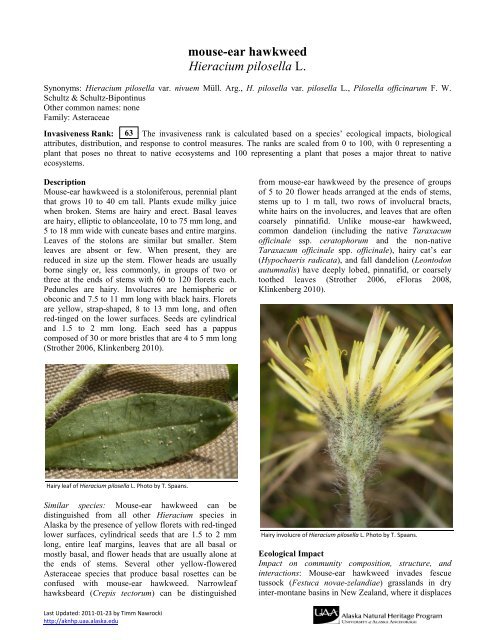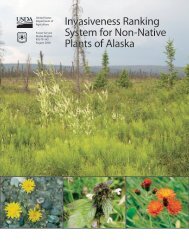mouse-ear hawkweed Hieracium pilosella L. - Alaska Natural ...
mouse-ear hawkweed Hieracium pilosella L. - Alaska Natural ...
mouse-ear hawkweed Hieracium pilosella L. - Alaska Natural ...
- No tags were found...
Create successful ePaper yourself
Turn your PDF publications into a flip-book with our unique Google optimized e-Paper software.
<strong>mouse</strong>-<strong>ear</strong> <strong>hawkweed</strong><strong>Hieracium</strong> <strong>pilosella</strong> L.Synonyms: <strong>Hieracium</strong> <strong>pilosella</strong> var. nivuem Müll. Arg., H. <strong>pilosella</strong> var. <strong>pilosella</strong> L., Pilosella officinarum F. W.Schultz & Schultz-BipontinusOther common names: noneFamily: AsteraceaeInvasiveness Rank: 63 The invasiveness rank is calculated based on a species’ ecological impacts, biologicalattributes, distribution, and response to control measures. The ranks are scaled from 0 to 100, with 0 representing aplant that poses no threat to native ecosystems and 100 representing a plant that poses a major threat to nativeecosystems.DescriptionMouse-<strong>ear</strong> <strong>hawkweed</strong> is a stoloniferous, perennial plantthat grows 10 to 40 cm tall. Plants exude milky juicewhen broken. Stems are hairy and erect. Basal leavesare hairy, elliptic to oblanceolate, 10 to 75 mm long, and5 to 18 mm wide with cuneate bases and entire margins.Leaves of the stolons are similar but smaller. Stemleaves are absent or few. When present, they arereduced in size up the stem. Flower heads are usuallyborne singly or, less commonly, in groups of two orthree at the ends of stems with 60 to 120 florets each.Peduncles are hairy. Involucres are hemispheric orobconic and 7.5 to 11 mm long with black hairs. Floretsare yellow, strap-shaped, 8 to 13 mm long, and oftenred-tinged on the lower surfaces. Seeds are cylindricaland 1.5 to 2 mm long. Each seed has a pappuscomposed of 30 or more bristles that are 4 to 5 mm long(Strother 2006, Klinkenberg 2010).from <strong>mouse</strong>-<strong>ear</strong> <strong>hawkweed</strong> by the presence of groupsof 5 to 20 flower heads arranged at the ends of stems,stems up to 1 m tall, two rows of involucral bracts,white hairs on the involucres, and leaves that are oftencoarsely pinnatifid. Unlike <strong>mouse</strong>-<strong>ear</strong> <strong>hawkweed</strong>,common dandelion (including the native Taraxacumofficinale ssp. ceratophorum and the non-nativeTaraxacum officinale spp. officinale), hairy cat’s <strong>ear</strong>(Hypochaeris radicata), and fall dandelion (Leontodonautumnalis) have deeply lobed, pinnatifid, or coarselytoothed leaves (Strother 2006, eFloras 2008,Klinkenberg 2010).Hairy leaf of <strong>Hieracium</strong> <strong>pilosella</strong> L. Photo by T. Spaans.Similar species: Mouse-<strong>ear</strong> <strong>hawkweed</strong> can bedistinguished from all other <strong>Hieracium</strong> species in<strong>Alaska</strong> by the presence of yellow florets with red-tingedlower surfaces, cylindrical seeds that are 1.5 to 2 mmlong, entire leaf margins, leaves that are all basal ormostly basal, and flower heads that are usually alone atthe ends of stems. Several other yellow-floweredAsteraceae species that produce basal rosettes can beconfused with <strong>mouse</strong>-<strong>ear</strong> <strong>hawkweed</strong>. Narrowleafhawksb<strong>ear</strong>d (Crepis tectorum) can be distinguishedHairy involucre of <strong>Hieracium</strong> <strong>pilosella</strong> L. Photo by T. Spaans.Ecological ImpactImpact on community composition, structure, andinteractions: Mouse-<strong>ear</strong> <strong>hawkweed</strong> invades fescuetussock (Festuca novae-zelandiae) grasslands in dryinter-montane basins in New Zealand, where it displacesLast Updated: 2011-01-23 by Timm Nawrockihttp://aknhp.uaa.alaska.edu
inter-tussock vegetation first and then fescue tussock.Infestations spread extensively, reaching up to 80%ground cover (Makepeace 1985). Dense mats of rosettesreduce the quality of pastures for sheep in New Zealand(Scott et al. 1990). This species also grows in densemats and excludes desirable species in meadows andpastures in the eastern U.S. (Washington NWCB 2008).Mouse-<strong>ear</strong> <strong>hawkweed</strong> can significantly increase thedensity of forb-graminoid layers and displace nativespecies in grasslands (Makepeace 1985, Piening andRusso 1988). <strong>Hieracium</strong> species hybridize with othernative and non-native <strong>Hieracium</strong> species (Wilson 2006,Gaskin and Wilson 2007). Mouse-<strong>ear</strong> <strong>hawkweed</strong>reduces the amount of vegetation available for grazinganimals in grasslands in New Zealand (Makepeace1985).Impact on ecosystem processes: In New Zealand,<strong>mouse</strong>-<strong>ear</strong> <strong>hawkweed</strong> reduces the nitrogen andphosphorus content of fescue tussock, suggesting thatthis species limits the availability of nutrients(Makepeace et al. 1985). Infestations increase soil pHby up to 0.5 and increase the amount of organic carbonand soil exchangeable calcium, magnesium, andpotassium in the soil (McIntosh et al. 1995).Mat of <strong>Hieracium</strong> <strong>pilosella</strong> L. in a meadow in Germany. Photo by Conny.Biology and Invasive PotentialReproductive potential: Mouse-<strong>ear</strong> <strong>hawkweed</strong>reproduces sexually by seeds and vegetatively fromstolons (Makepeace 1985, Piening and Russo 1988).Individual rosettes produce 23 to 108 seeds (Winklerand Stöcklin 2002). Most seedlings do not survivelonger than several weeks (Piening and Russo 1988).Plants only produce stolons when initiatinginflorescences. Parent plants die after flowering, andstolons decay after vegetative rosettes root. Pioneerplants arise from seeds, but the maintenance andexpansion of populations primarily depend onvegetative reproduction (Makepeace 1985, Winkler andStöcklin 2002). The amount of time seeds remain viablefor this species is unknown, but <strong>Hieracium</strong> speciesoftem maintain seed viability for seven y<strong>ear</strong>s (Rinellaand Sheley 2002).Role of disturbance in establishment: Mouse-<strong>ear</strong><strong>hawkweed</strong> establishes on open soil or in sparselyvegetated areas (Piening and Russo 1988). It grows inanthropogenically disturbed areas in North America(Strother 2006, Klinkenberg 2010). In New Zealand, ithas established in extensively grazed short tussockgrassland (Makepeace 1985). Although <strong>Hieracium</strong>species do not readily germinate in heavily vegetatedareas, populations may spread vegetatively intoundisturbed areas once established (Giroday and Baker2006).Potential for long-distance dispersal: Each seed has apappus composed of 30 or more bristles that are 4 to 5mm long (Strother 2006). Seeds are dispersed by wind(Makepeace 1985).Potential to be spread by human activity: Mouse-<strong>ear</strong><strong>hawkweed</strong> was likely introduced to New Zealand incontaminated crop seed (Makepeace 1985).Germination requirements: Seeds germinate in springand autumn when sufficient moisture is present.Germination rates are highest at 22°C (Piening and Russo1988).Growth requirements: Mouse-<strong>ear</strong> <strong>hawkweed</strong> usuallygrows in well-drained, coarse, nutrient-poor soils in dryareas. Low annual rainfall favors the establishment ofthis species (Piening and Russo 1988). As populationsexpand by stolons outward from a center, gaps form inthe center where parent plants die. On shallow, drysoils, the gaps are not recolonized (Makepeace 1985).Congeneric weeds: All <strong>Hieracium</strong> species areconsidered noxious weeds in Washington. Polar<strong>hawkweed</strong> (<strong>Hieracium</strong> atratum), orange <strong>hawkweed</strong> (H.aurantiacum), meadow <strong>hawkweed</strong> (H. caespitosum), H.×floribundum (no common name), tall <strong>hawkweed</strong> (H.piloselloides), and common <strong>hawkweed</strong> (H. vulgatum)are each considered a noxious weed in one or morestates of the U.S. or provinces of Canada (Invaders2011, USDA 2011).Legal ListingsHas not been declared noxiousListed noxious in <strong>Alaska</strong>Listed noxious by other states (All <strong>Hieracium</strong> species:WA; <strong>Hieracium</strong> <strong>pilosella</strong>: OR)Federal noxious weedListed noxious in Canada or other countries (QC)Distribution and AbundanceIn North America, <strong>mouse</strong>-<strong>ear</strong> <strong>hawkweed</strong> grows inLast Updated: 2011-01-23 by Timm Nawrockihttp://aknhp.uaa.alaska.edu
disturbed areas, sand, gravel, fields, lawns, androadsides (Strother 2006, Klinkenberg 2010). It is aweed of pastures in North America and New Zealand(Davy and Bishop 1984, Piening and Russo 1988, Scottet al. 1990).Native and current distribution: Mouse-<strong>ear</strong> <strong>hawkweed</strong>is native to Europe (Piening and Russo 1988, Strother2006). It was introduced to North America and NewZealand in the <strong>ear</strong>ly 20 th century (Piening and Russo1988). This species grows in 23 states of the U.S. in thePacific Northwest and eastern U.S. (Strother 2006,USDA 2011). It has also been introduced to SouthAmerica (Cipriotti et al. 2010). Mouse-<strong>ear</strong> <strong>hawkweed</strong>grows as far north as 67.9°N in Norway (NorwegianSpecies Observation Service 2011). It has beendocumented from Girdwood and Prince of Wales Islandin the Pacific Maritime ecogeographic region of <strong>Alaska</strong>and Kenai in the Interior-Boreal ecogeographic region(AKEPIC 2011, UAM 2011).Pacific MaritimeInterior-BorealArctic-AlpineCollection SiteManagementThe addition of nitrogen, potassium, and phosphorus tograsslands increases populations of native grasses andreduces or eliminates populations of <strong>mouse</strong>-<strong>ear</strong><strong>hawkweed</strong>. Increased nutrient levels stimulateflowering, which increases the turnover of rosettes sinceparent plants die after flowering (Davy and Bishop1984). Mouse-<strong>ear</strong> <strong>hawkweed</strong> can be controlled by theapplication of 2, 4-D ester at 1,000 g/ha combined withclopyralid at 400 g/ha (Piening and Russo 1988).Aminopyralid at 105 grams per hectare and clopyralid at420 grams per hectare consistently controlled orange<strong>hawkweed</strong> (<strong>Hieracium</strong> aurantiacum) infestations insouthern <strong>Alaska</strong> and may provide effective control of<strong>mouse</strong>-<strong>ear</strong> <strong>hawkweed</strong> as well. Aminopyralid is bettersuited to pasture habitats as it controls a broaderspectrum of forbs than clopyralid, while clopyralid isbetter suited to natural habitats as it will remove less ofthe native vegetation (Seefeldt and Conn 2010).Mechanical control efforts have not been investigated;however, similar to orange <strong>hawkweed</strong>, mechanicalcontrol efforts are likely ineffective. Mouse-<strong>ear</strong><strong>hawkweed</strong> can resprout from root and stolon fragments(King County 2010); for this reason, tilling is notrecommended.Distribution of <strong>mouse</strong>-<strong>ear</strong> <strong>hawkweed</strong> in <strong>Alaska</strong>References:AKEPIC database. <strong>Alaska</strong> Exotic Plant InformationCl<strong>ear</strong>inghouse Database. 2011. Available:http://akweeds.uaa.alaska.edu/Cipriotti, P., R. Rauber, M. Collantes, K. Braun, and C.Escartín. 2010. <strong>Hieracium</strong> <strong>pilosella</strong> invasion inthe Tierra del Fuego steppe, SouthernPatagonia. Biological Invasions. 12(8). 2523-2535 p.Davy, A., and G. Bishop. 1984. Response of <strong>Hieracium</strong><strong>pilosella</strong> in Breckland grass-heath to inorganicnutrients. Journal of Ecology. 72(1). 319-330 p.eFloras. 2008. Published on the Internethttp://www.efloras.org [accessed 22 September2010]. Missouri Botanical Garden, St. Louis,MO & Harvard University Herbaria,Cambridge, MA.Gaskin, J., and L. Wilson. 2007. PhylogeneticRelationships Among Native and <strong>Natural</strong>ized<strong>Hieracium</strong> (Asteraceae) in Canada and theUnited States Based on Plastid DNASequences. Systematic Botany. 32(2). 478-485p.Giroday, H., and V. Baker. 2006. Invasive <strong>hawkweed</strong>s(<strong>Hieracium</strong> ssp.) in Northeastern BritishColumbia. Invasive Plants Program, RangeBranch, British Columbia Ministry of Forestsand Range. Prince George, BC. [6 February2011]http://www.for.gov.bc.ca/hra/Publications/invasive_plants/HawkweeedRiskAssessmentforNortheastBC_FINAL_24Oct06.pdfInvaders Database System. 2011. University ofMontana. Missoula, MT.http://invader.dbs.umt.edu/King County. 2010. Best Management Practices,Hawkweeds, <strong>Hieracium</strong> spp. Noxious WeedControl Board, King County. [17 January 2011]http://your.kingcounty.gov/dnrp/library/waterand-land/weeds/BMPs/<strong>hawkweed</strong>-control.pdfKlinkenberg, B. (Editor) 2010. <strong>Hieracium</strong> <strong>pilosella</strong> L.In: E-Flora BC: Electronic Atlas of the Plantsof British Columbia. Lab for Advanced SpatialAnalysis, Department of Geography, Universityof British Columbia. Vancouver, BC. [17January 2011] Available:http://www.geog.ubc.ca/biodiversity/eflora/index.shtmlMakepeace, W. 1985. Growth, reproduction, andLast Updated: 2011-01-23 by Timm Nawrockihttp://aknhp.uaa.alaska.edu
production biology of <strong>mouse</strong>-<strong>ear</strong> and king devil<strong>hawkweed</strong> in eastern South Island, NewZealand. New Zealand Journal of Botany. 23.65-78 p.Makepeace, W., A. Dobson, D. Scott. 1985. Interferencephenomena due to <strong>mouse</strong>-<strong>ear</strong> and king devil<strong>hawkweed</strong>. New Zealand Journal of Botany.23. 79-90 p.McIntosh, P., M. Loeseke, and K. Bechler. 1995. Soilchanges under <strong>mouse</strong>-<strong>ear</strong> <strong>hawkweed</strong>(<strong>Hieracium</strong> <strong>pilosella</strong>). New Zealand Journal ofEcology. 19(1). 29-34 p.Norwegian Species Observation Service. 2011.Accessed through GBIF (Global BiodiversityInformation Facility) data portal(http://data.gbif.org/datasets/resource/11831,2011-01-17). Norwegian BiodiversityInformation Centre (NBIC). Trondheim,Norway.Piening, C., and M. Russo. 1988. Element StewarshipAbstract for <strong>Hieracium</strong> <strong>pilosella</strong>, Mouse-EarHawkweed. The Nature Conservancy. [17January 2011] Available:http://www.imapinvasives.org/GIST/ESA/esapages/documnts/hierpilo.pdfRinella, M., and R. Sheley. 2002. Orange and meadow<strong>hawkweed</strong>. Montana State UniversityExtension Service. Bozeman, MT. [6 February2011] Available:http://www.montana.edu/wwwpb/pubs/Scott, D., J. Robertson, and W. Archie. 1990. Plantdynamics of New Zealand tussock grasslandsinfested with <strong>Hieracium</strong> <strong>pilosella</strong>. I. Effects ofseasonal grazing, fertilizer, and overdrilling.Journal of Applied Ecology. 27(1). 224-234 p.Seefeldt, S., and J. Conn. 2010. Control of OrangeHawkweed (<strong>Hieracium</strong> aurantiacum) inSouthern <strong>Alaska</strong>. Invasive Plant Science andManagement. In Press.Strother, J. 2006. <strong>Hieracium</strong> <strong>pilosella</strong> Linnaeus. In:Flora of North America Editorial Committee,eds. 1993+. Flora of North America North ofMexico. 12+ vols. New York and Oxford. Vol.19, p. 283.UAM. 2011. University of <strong>Alaska</strong> Museum, Universityof <strong>Alaska</strong> Fairbanks. Available:http://arctos.database.museum/home.cfmUSDA. 2011. The PLANTS Database. National PlantData Center, <strong>Natural</strong> Resources ConservationService, United States Department ofAgriculture. Baton Rouge, LA.http://plants.usda.govWashington NWCB. 2008. Written Findings of theWashington State Noxious Weed ControlBoard <strong>Hieracium</strong> <strong>pilosella</strong>. Washington StateNoxious Weed Control Board. Olympia, WA.[17 January 2011]http://www.nwcb.wa.gov/weed_info/<strong>Hieracium</strong>_<strong>pilosella</strong>.htmlWilson, L. 2006. Key to Identification of Invasive andNative Hawkweeds (Hiercaium spp.) in thePacific Northwest. Invasive Alien PlantProgram, Forest Practices Branch, BritishColumbia Ministry of Forests and Range.Kamloops, BC.Winkler, E., and J. Stöcklin. 2002. Sexual andVegetative Reproduction of <strong>Hieracium</strong><strong>pilosella</strong> L. under Competition andDisturbance: a Grid-based Simulation Model.Annals of Botany. 89(5). 525-536 p.Last Updated: 2011-01-23 by Timm Nawrockihttp://aknhp.uaa.alaska.edu
















